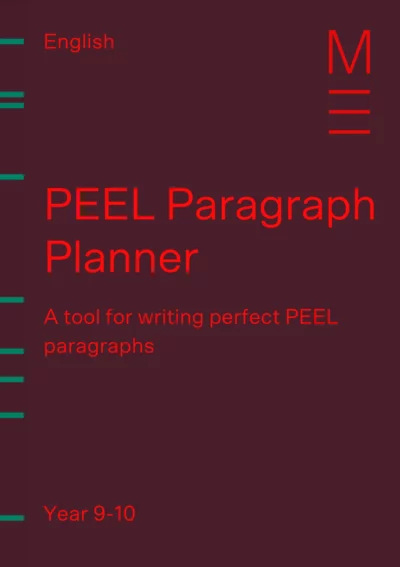Welcome to Matrix Education
To ensure we are showing you the most relevant content, please select your location below.
Select a year to see courses
Learn online or on-campus during the term or school holidays
Learn online or on-campus during the term or school holidays
Learn online or on-campus during the term or school holidays
Learn online or on-campus during the term or school holidays
Learn online or on-campus during the term or school holidays
Learn online or on-campus during the term or school holidays
Learn online or on-campus during the term or school holidays
Get HSC Trial exam ready in just a week
Get HSC exam ready in just a week
Select a year to see available courses
Science guides to help you get ahead
Science guides to help you get ahead
In this article, we're going to take the mystery out of paragraphs and give you the ultimate PEEL paragraph checklist.

Join 75,893 students who already have a head start.
"*" indicates required fields
You might also like
Related courses

Join 8000+ students each term who already have a head start on their school academic journey.
PEEL paragraph. TEEL paragraph.
You’ve heard the acronyms, but what are they, really? Is there a difference? More importantly, how are you meant to write one and what are you meant do in one?

Learn to write detailed and insightful paragraphs and score better marks!

Fill out your details below to get this resource emailed to you.
"*" indicates required fields
Don’t worry, in this post we going to show you how we’ve helped students master paragraph writing over the last 18 years. What we going to do is explain in simple terms what a PEEL paragraph is, what it’s meant to do, and how to write a spectacular one that will blow your teachers socks off!
Essentially, a paragraph is an interconnected set of sentences that focus on and support a single idea. A PEEL paragraph is a way of structuring information in a series of connected sentences. PEEL stands for:
A useful way to think of paragraphs is to think of them as part of a hierarchy of information – something akin to a family. That is to say, the more information we to add, the larger and more complex the hierarchy becomes. We can simplify it by thinking of it as having the following three levels in a pyramid:
A PEEL paragraph presents information in a clearly structured and logical manner. The sentences work together as follows:
Do you have to write TEEL sentences instead of PEEL paragraphs? Yes? Then you’re probably wondering if there’s a difference.
Different schools teach paragraph structure in different ways. Some schools will use P.E.E.L and T.E.E.L interchangeably, where the “P” stands for point or the “T” for topic.
Other schools will teach T.E.E.L paragraphs that are a little bit more complex than P.E.E.L paragraphs. For example, when Matrix students are taught to write T.E.E.L paragraphs, the “T” stands for technique and students are taught to present their evidence to support the topic sentence. P.E.E.L paragraphs are a good stepping stone for students in younger years to learn how to develop an argument.
So, while the acronyms are different and one is a little more advanced than the other, the concepts are the same. The idea is to provide a hierarchy to your idea and the evidence that supports it.
When you write a TEEL or PEEL paragraph you are developing and supporting an idea in order to convince an audience of your argument.
Really, whether the acronym is PEEL or TEEL or something else is largely irrelevant. What is important is the systematic process of how you present your information:
When you are trying to communicate your thoughts about an idea, you must structure them in a manner that makes them accessible for others to understand. It is important to remember that when you write an essay, you are not writing for you, you are really writing for your audience.
Paragraphs allow you to give others insights into your thoughts. Because of this it is important that you step your reader through your thought processes.
TEEL paragraphs are a good way of presenting information in a way that your readers will understand: they allow you introduce an idea and then explain your thoughts on it in a clear and systematic way.
Now you know what a paragraph is meant to do and what the structure of a TEEL or PEEL paragraph is, let’s give you a checklist to work through so you can write insightful paragraphs yourself.
While the principle behind writing a paragraph is relatively simple, the process can be a little complex. To make your life easier and your work better, we’ve going to detail seven things you must do when writing paragraphs.
Let’s go!
This one may seem obvious, but is often the one that gets most overlooked: Planning!
When you’re in the heat of the moment and getting excited with your insights into a text, it is easy to skip over the planning step. After all, you know what you want to say, right?
Well, knowing what to say, and saying it in a manner that is accessible and understandable to your reader are two different things.
Planning will save you time in the long run, as it will mean that you don’t need to go back and keep changing things.
So, how should you plan?
Brainstorming is a good place to start. Think about what you’ve been asked to discuss and write down all of your ideas on a blank sheet of paper. Try to mark out the connections between these ideas.
This will allow you to start thinking about which examples will best support your points.
You can now start developing your paragraph.
What you need to do, is to take your idea and write it down succinctly in a way that introduces it to your readers.
Because essays are meant to be objective and, to an extent, impartial you should try to avoid using pronouns I or me. It is already clear whose idea it is, because it is YOUR essay.
If you are unsure how to write a good topic sentence, you should read our post: How to Write A Topic Sentence.
As an example, let’s consider the following question:
Let’s say that we wanted to discuss how Shakespeare is presenting the popular argument that people who overthrow or murder a king or queen are destined to come to a sticky end (they usually die in Shakespeare’s plays – often brutally). what would that look like as a topic sentence?
“Shakespeare’s depiction of Macbeth’s downfall illustrates that those who usurp the throne are destined to fail and be punished.”
The above statement is succinct and addresses the question. It also paves the way for you to develop the idea in further detail by presenting an example and discussing why that example supports your point.
Let’s see what this would look like.
A topic sentence without supporting evidence and a supporting argument is just hearsay. You are stating something without backing it up. This won’t work if you want good marks, so you need to back it up.
To do this, you need to ask yourself, “what example best supports what I am trying to say?”
You’ll probably come up with a couple of different examples that you need to choose between.
If this is the case, and you only need one, you need to pick which one is going to be most compelling or persuasive. So, how do you decide?
Well, you want to think about which example has the more powerful technique to convey information.
A good way to make this decision is to distinguish between higher order and lower order techniques. For example, if one example utilises alliteration and the other metaphor you’d choose the example that uses metaphor. Why?
On the one hand, alliteration is largely a superficial technique, it creates a stylistic effect but doesn’t carry a lot of meaning. On the other hand, metaphor is a difficult technique to get right and it carries a lot of meaning to readers.
For example, in Macbeth in Act 5 Scene 5, the titular character realises that his violent and bloody actions may well be for nothing. He says:
Life’s but a walking shadow, a poor player
That struts and frets his hour upon the stage
And then is heard no more: it is a tale
Told by an idiot, full of sound and fury,
Signifying nothing. (5.5.28-32)
In this example, there is alliteration in the first line where life is described as a “poor player” – that is an actor on stage. This alliteration is stylistic, but it doesn’t carry as much meaning as the extended metaphor that it is part of – one that describes life as an empty and poorly written play with a hollow and unsatisfactory ending.
Instead, the extended metaphor conveys the most meaning comparing life, Macbeth’s life, with that of a fleeting actor who’s time is brief and ultimately forgettable. This idea is best conveyed in the metaphor at the end of the larger quotation: “it is a tale / told by an idiot, full of sound and fury, / signifying nothing.”
Now you know how to pick the example, you need to put it into a full sentence.
When you present an example in you PEEL paragraph, you want to present it in a way that carries the most information. You also want to do it in a way that presents it in an accessible and direct manner.
What do we mean, exactly? If you present your example in it’s own sentence it is not going to have enough context. And if you don’t introduce an example clearly, it can be hard to discern why you’re presenting the example.
To get a better idea of this, let’s look at what you shouldn’t do. Here are some examples of presenting quotations in an inappropriate manner. We’ll use this quotation from Macbeth act 5 scene 5: it is a tale / told by an idiot, full of sound and fury, / signifying nothing.
The first one of these gives no context for the quotation. The reader doesn’t know why you’ve picked it.
The second one of these is very vague and does’t really explain what the quotation is about or why it is important to you or even who says it.
The third one gives a little bit of context about who is saying things, but it doesn’t frame it in relation to an argument.
The best way to present an example is to include context and maybe even the technique.
So, what does that look like? Well if we want to provide the context – that Macbeth says it and that he says it in the final scenes of the play before his world comes crashing down – and frame the quotation for the reader – that it is a metaphor and it is characterising the Pyrrhic nature of his victory – then it should like this:
As you can see, the above sentence is a sophisticated statement that frames and introduces the example while incorporating the quotation to ensure that the reader knows why you have chosen it.
Now you’ve introduced the example, you need to explain what’s happening in it and why you think it is important.
When you are explaining an example, you need to convey:
As you can see this is a lot of information, so you may need to write two or more sentences to convey it all.
What you want to ensure is that you make your understanding of the three points above clear for your reader. This is the most important part of your argument as it explains your critical thinking process.
It is very important that you don’t worry about stating the obvious.
What might be startlingly obvious for you may not be at all clear for your reader.
If we go back to our previous example from Macbeth, we need to explain why this example and our analysis of it supports our argument. Let’s recap by looking at what we’ve come up with so far:
Shakespeare’s depiction of Macbeth’s downfall illustrates that those who usurp the throne are destined to fail and be punished. In Act 5 Scene 5, Macbeth begins to face the fact his actions may have been for nothing and uses the metaphor that his life, like the player’s, is “a tale / told by an idiot, full of sound and fury, / signifying nothing.”
What we need to do now is to explain why we find this example and technique compelling. Here is our reason:
Now we need to write this succinctly for the reader:
“Shakespeare uses this metaphor to convey that the opportunity to make a lasting impact on the world is easily squandered by an individual’s moral transgressions. Macbeth’s statement is a moment of anagnorisis, he is realising that his immoral acts of violence and barbarism will cost him his life, crown, and legacy.”
Notice that this is two sentences and quite detailed. This is because we must provide as much information as we need for somebody else to understand our thinking.
Now to finish the paragraph.
The final part of the PEEL sentence is the statement that links it to your broader argument or a closing statement that summarises the argument you’ve just made.
If the paragraph is part of a larger essay, the linking statement should summarise the content and idea you’ve just presented and frame it in the context of the wider argument you are making.
If the paragraph is a shorter response to a specific question you need to summarise your argument.
Let’s assume that our paragraph is part of a broader argument. In this case, we will need to signal our next argument. Let’s say that we’re going to develop a discussion of the Great Chain of Being in our next paragraph.
For example, we might argue that in Shakespeare’s time, audiences believed in the Great Chain of Being where it was God who chose Kings and Queens. By murdering a king – like Macbeth did Duncan -it would bring God’s ire who would eventually right the order by bringing vengeance on the murder and putting a rightful king or queen in their place. Macbeth is aware that he is likely to be replaced, just as a playwright or director can replace an actor who performs poorly.
Our linking statement, then, would look something like this:
The above statement summarises the initial argument and signals what we will talk about next.
So, our finished paragraph looks like:
Shakespeare’s depiction of Macbeth’s downfall illustrates that those who usurp the throne are destined to fail and be punished. In Act 5 Scene 5, Macbeth begins to face the fact his actions may have been for nothing and uses the metaphor that his life, like the player’s, is “a tale / told by an idiot, full of sound and fury, / signifying nothing. “Shakespeare uses this metaphor to convey that the opportunity to make a lasting impact on the world is easily squandered by an individual’s moral transgressions. Macbeth’s statement is a moment of anagnorisis, he is realising that his immoral acts of violence and barbarism will cost him his life, crown, and legacy. Clearly, Macbeth’s downfall demonstrates to us that villains will be consumed by guilt but also that they will be punished for challenging the Divine Order of the world.
You’ve finished writing the paragraph, so you’re done, right? No!
What you must do is proof read and edit your paragraph. Good marks come to those who take the time to check their work for mistakes.
You want to read back through your work and look for:
When you find errors, make sure that you correct them. A good way to check your work for mistakes is to read it aloud.
Just to make sure it is all correct, read through it again before you submit your work.
With Matrix+, we provide you with clear and structured online lesson videos, quality resources, and forums to ask your Matrix teachers questions and for feedback.
Learn more about our Matrix+ Online English course now.

Learn to write detailed and insightful paragraphs and score better marks!

Fill out your details below to get this resource emailed to you.
"*" indicates required fields
Written by Matrix English Team
The Matrix English Team are tutors and teachers with a passion for English and a dedication to seeing Matrix Students achieving their academic goals.© Matrix Education and www.matrix.edu.au, 2025. Unauthorised use and/or duplication of this material without express and written permission from this site’s author and/or owner is strictly prohibited. Excerpts and links may be used, provided that full and clear credit is given to Matrix Education and www.matrix.edu.au with appropriate and specific direction to the original content.